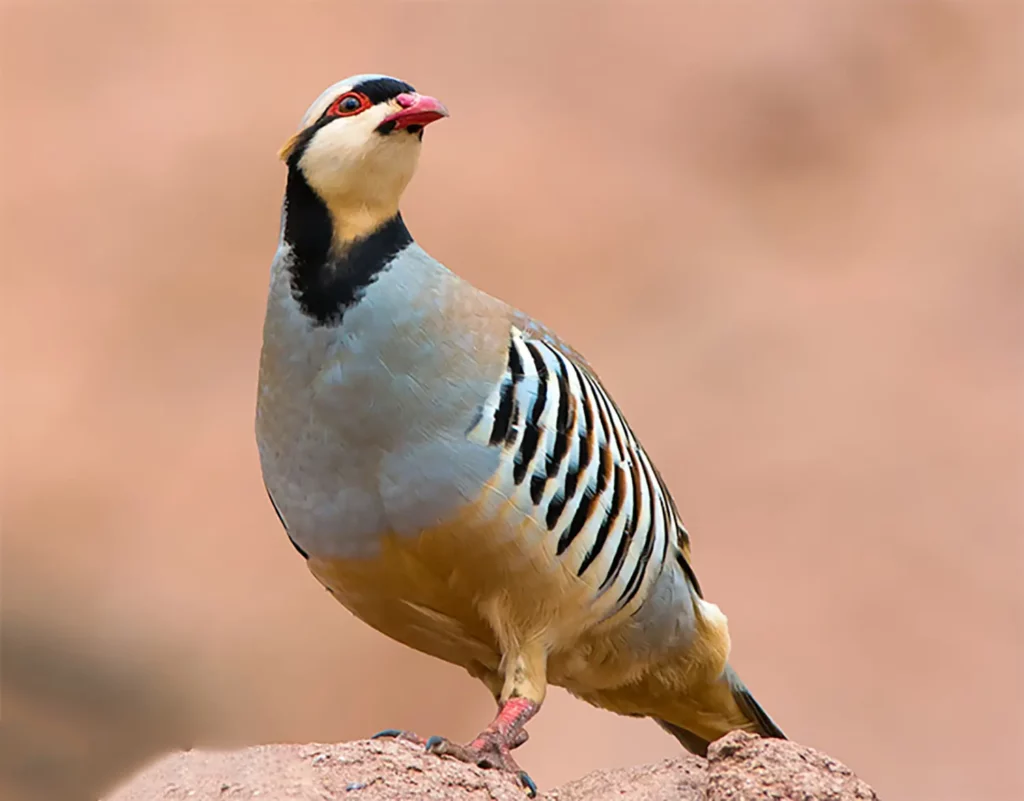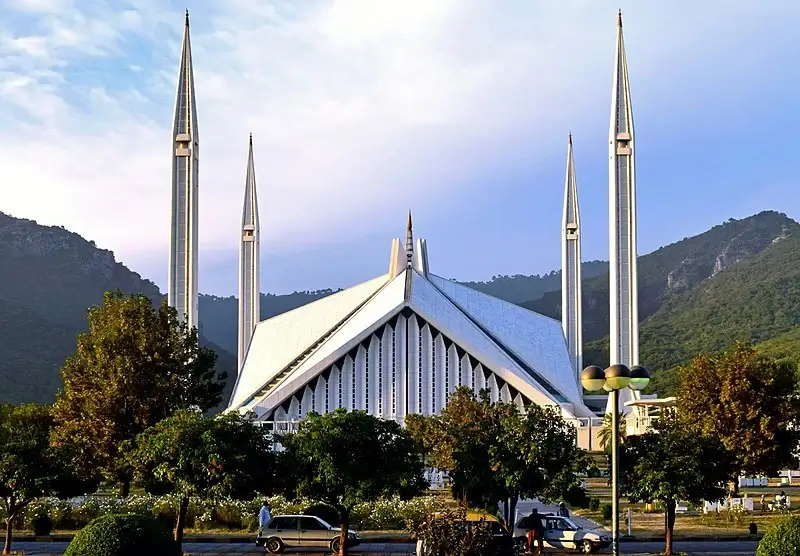Pakistan, a country founded only over seven decades ago, has various national symbols that represent the heritage and pride of the nation. These symbols have their origins from before Pakistan’s inception and hold significant value in the country’s political, social, and cultural spectrum.
Each emblem carries a unique meaning and represents Pakistan’s rich cultural and historical background. In this blog post, we will take a deep dive into the national symbols of Pakistan, their significance and importance.
Here is our deatailed post about the recent changes in the political map of Pakistan.
List of National Symbols of Pakistan with Pictures
National Flag: The flag of Pakistan is a green field with a white crescent moon and a five-rayed star at its center, and a vertical white stripe at the hoist side. It represents the country’s commitment to Islam and the rights of religious minorities.

National Animal: Markhor: The Markhor is a large species of wild goat that is found in northeastern Afghanistan, northern and central Pakistan, Northern India, southern Tajikistan and southern Uzbekistan.

National Bird: Chukar Partridge: The Chukar Partridge is a Eurasian upland gamebird in the pheasant family Phasianidae.

National Flower: Jasmine: Jasmine is a genus of shrubs and vines in the olive family. It is known for its intense fragrance and is widely cultivated for its flowers.

National Tree: Deodar: Deodar is a species of cedar native to the western Himalayas in eastern Afghanistan, northern Pakistan, and India, south western most Tibet and western Nepal.

National Mosque: Faisal Mosque: The Faisal Mosque is the largest mosque in Pakistan, located in the national capital city of Islamabad.

National Mausoleum: Mazar-e-Quaid: Mazar-e-Quaid is the tomb of the founder of Pakistan, Muhammad Ali Jinnah.

The National Flag
History of the National Flag
The national flag of Pakistan was designed by Syed Amir-uddin Kedwaii and was officially adopted by the Constituent Assembly on August 11, 1947, three days before the country’s independence.
Design and Meaning
The flag comprises a green field with a white stripe on the left, and there is a white star and crescent in the green field. The flag design holds deep symbolic significance for Pakistan.
- Green Field: The larger portion of the flag is dark green in color, representing the Muslim majority of Pakistan. This vibrant green color symbolizes prosperity and good fortune.
- White Stripe: The white stripe on the left represents religious minorities and minority religions in Pakistan. It signifies the country’s commitment to both religious and ethnic diversity.
- Star and Crescent: The white star and crescent are traditional symbols of Islam, and they symbolize light and progress, respectively. The star’s five points denote the five pillars of Islam.
Creator’s Vision
Syed Amir-uddin Kedwaii, an intellectual and scholar, aimed to design a flag that would encapsulate Pakistan’s ideological foundation and vision. He wanted the flag to represent not just the Muslim majority but also to pay respect to minority religions, hence the white stripe. The star and crescent were incorporated as a nod to the Islamic faith, which is the religion of the majority in Pakistan.
The National Emblem
History of the National Emblem
The National Emblem of Pakistan was adopted in 1954, seven years after the country’s independence. It was designed by Chaudhry Abdul Malik, a renowned architect and artist of his time.
Design and Symbolism
The emblem is highly symbolic, incorporating multiple elements that each represent a unique aspect of Pakistan.
- Shield: The central feature of the emblem is a shield which is divided into four parts, each featuring a major product of Pakistan: cotton, wheat, tea, and jute. These represent the country’s agricultural strength.
- Floral Wreath: Surrounding the shield is a floral wreath of Jasmine, the national flower of Pakistan, implying the aesthetic taste of the people of Pakistan and their love for arts and culture.
- Banner: Below the shield, a scroll contains the national motto of Pakistan in Urdu, which translates as “Faith, Unity, Discipline.” These words were the guiding principles for the nation’s founder, Quaid-e-Azam Muhammad Ali Jinnah.
- The Crescent and Star: Above the shield, the green crescent and star – a representation of Islam and also features on the national flag – signify the ideological foundation of Pakistan.
Public Interest Facts
The National Emblem of Pakistan appears on all official documents, including Pakistani passports, and is etched into government buildings and Pakistani embassies worldwide. Its design illustrates the diversity and unity of Pakistan, celebrating both its cultural heritage and vision for the future. The emblem encapsulates the values and ambitions of Pakistan, serving as a reminder of the country’s identity and ethos.
The National Animal
The Markhor: Pakistan’s Majestic National Animal
Introduction:
- The national animal of Pakistan is the Markhor, a large species of wild goat known for its unique twisted horns.
- This resilient animal is native to the mountainous regions of northern and western Pakistan, primarily residing in the Himalayas, Karakoram, and the Hindukush ranges.
Facts about the Markhor:
- Incredible Agility and Adaptability:
- The Markhor is known for its incredible agility and ability to navigate the rugged, rocky terrain of its high-altitude home.
- It has adapted to survive in harsh mountain environments.
- Majestic Spiral Horns:
- Adult male Markhors possess a majestic pair of spiral horns that can grow up to 160 cm long.
- These horns add to their visual appeal and symbolic significance.
- Meaning Behind the Name:
- The name ‘Markhor’ is derived from two Persian words, ‘Mar’ meaning snake and ‘khor’ meaning eater.
- However, it’s more likely that the name refers to the snake-like twist in its horns.
Role in Ecosystem:
- The Markhor plays a significant role in local ecosystems by controlling vegetation growth and providing prey for large predators like snow leopards and wolves.
- It helps maintain a balanced ecosystem.
Conservation Status:
- Despite being classified as “Near Threatened” on the IUCN Red List, dedicated conservation efforts have helped increase its population over recent years.
- Conservation initiatives have played a vital role in preserving this majestic species.
Symbolism:
- The choice of Markhor as the national animal of Pakistan symbolizes the resilience and independence of the nation.
- Just like the Markhor, Pakistan has endured tough times and continues to stand strong, reflecting the spirit of survival and determination.
The National Flower
Jasmine – The National Flower
Beauty in Simplicity
- Jasmine, with its simple beauty and intoxicating fragrance, has been chosen as the national flower of Pakistan.
- The pure white petals symbolize the country’s love for peace and the simple yet profound beauty of its people.
Cultural and Traditional Significance
- Traditionally used in weddings, Jasmine holds immense cultural and emotional significance for the people of Pakistan.
- Being a part of important life events, it is often associated with love, happiness, and new beginnings.
Medicinal Uses
- Apart from its beauty, Jasmine also has medicinal uses.
- Its oil is known for its calming effects and is used in aromatherapy treatments.
- It is also used in teas and herbal remedies for its potential health benefits.
Role in Ecosystem
- Jasmines play a significant role in maintaining the local ecosystem.
- They provide nectar for pollinators like bees and butterflies, thus aiding in the process of pollination.
Conservation Efforts
- Sustained efforts are being made to protect and propagate Jasmine due to its environmental, cultural, and medicinal importance.
- These efforts include spreading awareness about the flower’s significance, promoting its cultivation, and protecting its natural habitats.
Symbolism
- The choice of Jasmine as the national flower symbolizes the Pakistani people’s love for beauty, simplicity, and nature.
- Its resilience and ability to thrive in various conditions mirror the strength and resilience of the nation itself.
The National Bird

The Chukar Partridge
The Chukar Partridge, known for its robust and graceful demeanor, is recognized as the national bird of Pakistan. This bird, native to the rocky terrains of Eurasia and parts of Western Asia, is a symbol of resilience and endurance.
Physical Characteristics
The Chukar Partridge is characterized by its distinctive black and white stripes, stout body, and red beak. Its greyish-brown plumage allows it to blend seamlessly into its rocky habitats, while its robust legs are well-suited for its mountainous home.
Habitat and Behavior
These birds are found abundantly in the mountain ranges of Pakistan, where they thrive in steep, rugged terrains. Known for their loud, resonant call, Chukar Partridges are primarily ground-dwelling birds, although they can fly short distances when necessary.
Cultural Significance
The Chukar Partridge holds a significant place in Pakistani culture. Its melodious call is often featured in folk songs and tales, and its hardy nature symbolizes the strength and resilience of the Pakistani people.
Conservation Efforts
Efforts are being undertaken to preserve the Chukar Partridge’s natural habitats. These initiatives involve educating the public about the bird’s significance, restricting hunting, and implementing conservation programs to protect and increase their population.
The Chukar Partridge in Folklore and Literature
The Chukar Partridge’s presence extends beyond the physical realm, making a significant impact in folklore and literature. In various folklores, it is often portrayed as a bird of love and devotion, symbolizing intense and unrequited love. The bird’s call, believed to echo its yearning for its beloved, is a common theme in many traditional songs and poems.
National Drink of Pakistan

The National Drink of Pakistan: Sugarcane Juice
Sugarcane juice, locally known as ‘roh’, is the national drink of Pakistan. This refreshing drink is extracted from pressed sugarcane and is often served chilled with a dash of lemon and mint to enhance its flavor.
Reason for Selection
The selection of sugarcane juice as the national drink is deeply rooted in Pakistan’s agricultural and economic scenario. Sugarcane is one of the major crops grown in the country, contributing significantly to the national economy. Furthermore, its widespread consumption across the country and affordability made it a popular choice.
Selection Process
The process of adopting sugarcane juice as the national drink was not a formalized process but gradually evolved over the years due to its popularity and cultural significance. It became an unofficial symbol of national identity due to its wide acceptance and consumption across all regions and social strata. Over time, this acceptance was formalized, and sugarcane juice was recognized as the national drink of Pakistan.
National Fruit of Pakistan

The National Fruit of Pakistan: Mango
The Mango, lovingly referred to as the ‘King of Fruits’, is the national fruit of Pakistan. Known for its rich, sweet flavor and intoxicating aroma, it is a highly cherished fruit in the country.
The suggestion of the Mango as the national fruit of Pakistan did not originate from a single source. Over time, due to its popularity, widespread cultivation, and cultural significance, the Mango became a symbol of Pakistani identity. It is cherished by people from all walks of life, which led to its widespread acceptance as a national symbol. This collective recognition eventually led to its formalization as the national fruit of Pakistan, a status it enjoys to this day.
Variety and Production
Pakistan is home to a multitude of mango varieties, each with its unique taste and texture. The most popular varieties include ‘Sindhri’, ‘Chaunsa’, and ‘Anwar Ratol’. Each year, the country produces nearly 1.9 million tons of mangoes, making it the fifth largest producer of mangoes in the world.
Cultural Significance
The mango holds a significant place in the culture and traditions of Pakistan. The arrival of the mango season is celebrated with much fanfare, and mango festivals are commonplace during the summer months.
These festivals are not just about savoring the delicious fruit but also about promoting local produce and enhancing trade relationships.
Health Benefits
Mangoes are not just delicious, they’re also packed with numerous health benefits. They’re an excellent source of vitamins A and C, helping boost immunity. Furthermore, they are rich in dietary fiber, promoting digestive health.
The suggestion of the Mango as the national fruit of Pakistan did not originate from a single source. Over time, due to its popularity, widespread cultivation, and cultural significance, the Mango became a symbol of Pakistani identity.
It is cherished by people from all walks of life, which led to its widespread acceptance as a national symbol. This collective recognition eventually led to its formalization as the national fruit of Pakistan, a status it enjoys to this day.
National Game of Pakistan

Overview
National Game: Field Hockey
World Cup Victories:
- 1971
- 1978
- 1982
- 1994
Olympic Gold Medals:
- 1960
- 1968
- 1984
Renowned Players:
- Samiullah Khan (aka the “Flying Horse”)
- Sohail Abbas (holds the record for most goals scored in international field hockey)
Current Status
- Ranking: 17th in the world
Factors contributing to decline:
- Lack of funding
- Insufficient training facilities
National Tree of Pakistan
Overview
The national tree of Pakistan is the Deodar Cedar, or Cedrus deodara in scientific terms. This majestic tree is native to the western Himalayas and the eastern part of Afghanistan. It is widely admired for its natural beauty, height, and unique conical shape.
Description
The Deodar tree can reach heights of up to 250 feet, with a large conical crown in its early years that becomes cylindrical as the tree ages. Its wood is aromatic and durable, making it a favorite for construction and furniture making—particularly in the areas of roofing and paneling.
Significance in Pakistani Culture
The Deodar tree holds a special place in Pakistani culture. Its towering presence is seen as a symbol of endurance, strength, and natural beauty—qualities that are deeply rooted in the national character of Pakistan. The tree is also revered for its historical and spiritual significance, with many Deodar forests considered sacred by local communities.
Ecological Importance
Ecologically, the Deodar Cedar plays a crucial role. It helps maintain the health of the ecosystem by preventing soil erosion, providing a habitat for various wildlife species, and contributing to the area’s microclimate.
Conservation Status
Despite its importance, the Deodar tree faces threats from deforestation and climate change. Conservation efforts are underway to preserve this national treasure and to ensure its survival for future generations.
These include reforestation initiatives, strict regulation of Deodar wood harvesting, and community awareness programs about the ecological importance of the Deodar tree.
National Mosque of Pakistan

Introduction
The National Mosque of Pakistan, known as Faisal Mosque, is an iconic symbol of Islamabad, the capital city of Pakistan. Its modern and unique design, inspired by the Bedouin tent, stands out remarkably in contrast to the predominantly Mughal-inspired architecture of the country.
History
The mosque was designed by Turkish architect Vedat Dalokay and was completed in 1986. It was named after the late King Faisal bin Abdul-Aziz of Saudi Arabia, who contributed to its construction.
Architecture
One of the unique features of Faisal Mosque is its unconventional design. The mosque is shaped like a desert Bedouin’s tent and lacks the traditional domes seen in most Islamic architecture. It can accommodate over 100,000 worshippers, making it one of the largest mosques in the world.
Significance in Pakistani Culture
The Faisal Mosque holds a significant place in Pakistani culture. It is not just a place of worship, but also a major tourist attraction. The mosque’s modern architecture, coupled with its spiritual atmosphere, symbolizes the aspiration of the new generation of Pakistan to blend tradition with modernity.
Conservation and Maintenance
The mosque is well-maintained under the supervision of the government of Pakistan. Regular conservation efforts are made to ensure its structural integrity and aesthetic beauty. These include regular cleaning, minor repairs, and regular inspection of the mosque’s infrastructure.
Faisal Mosque is a vital symbol of Pakistan’s identity and Islamic heritage. Its striking design and cultural importance make it a must-see landmark for anyone visiting Islamabad.
National Mausoleum

Overview
The National Mausoleum, or Mazar-e-Quaid, is the final resting place of Quaid-e-Azam Muhammad Ali Jinnah, the founder of Pakistan. Located in Karachi, it is a significant national symbol and a testament to the struggle for Pakistan’s independence.
History
The construction of the mausoleum was completed in the 1960s, more than a decade after Jinnah’s death. The structure serves as a tribute to the man who spearheaded the movement for a separate homeland for the Muslims of the Indian subcontinent.
Architecture
Designed by architect Yahya Merchant, the mausoleum is an iconic example of modern Islamic architecture. It features a cubic base, topped by a large dome, all constructed from white marble. The complex also includes a museum dedicated to Jinnah’s life and work.
Significance
Mazar-e-Quaid serves as a symbol of respect and adoration for Muhammad Ali Jinnah. Each year, official and public ceremonies are held here on national holidays and anniversaries related to Jinnah’s life.
Conservation and Maintenance
The government of Pakistan oversees the upkeep of the mausoleum. Extensive conservation efforts are made to maintain the mausoleum’s grandeur, including regular cleaning, repairs, and security measures.
The surrounding gardens and park are also well maintained to provide a serene environment for visitors.
National Anthem of Pakistan

Overview
The National Anthem of Pakistan, known as “Qaumi Tarana” in Urdu, is a significant emblem of national unity and pride. Adopted in 1954, three years after the country’s inception, it is performed at state occasions and national holidays, standing as a powerful symbol of Pakistani identity.
Composition
The Qaumi Tarana was composed by Ahmad G. Chagla in 1950, a renowned musician of his time. However, the lyrics, written in highly Persianized Urdu, were not added until 1952. The lyrics were penned by Hafeez Jullundhri, whose words were chosen out of entries from a nationwide competition.
Lyrics and Translation
The lyrics of the anthem, though brief, are potent, encapsulating the vision and spirit of Pakistan. The three stanza composition pays homage to the land of Pakistan, its prosperity, and the ultimate desire for peace and brotherhood amongst its people. Despite the lyrics being primarily in Persian, the anthem is evocative for all Pakistanis.
Musical Structure
The Qaumi Tarana follows the music structure of a marching anthem, exhibiting a rhythmic harmony. The melody consists of eastern music tradition, incorporating 38 different tones of rich traditional orchestration.
Cultural and National Significance
The National Anthem of Pakistan is more than a song; it is a national symbol that represents the aspirations and hopes of the people of Pakistan. It is a source of unity, creating a sense of collective identity and fostering national pride.
Performance
The National Anthem is performed at various state and public events. It is customary to stand in respect when the anthem is played. It is also part of school assemblies, instilling a sense of patriotism from a young age.
Preservation and Promotion
The government of Pakistan ensures the anthem’s preservation and promotes its respectful rendition. The anthem is routinely broadcast on television and radio, reinforcing its standing as a critical element of Pakistan’s cultural and national identity.
National Anthem in Urdu
پاک سرزمین شاد باد
کشورِ حسین شاد باد
تو نشانِ عزمِ عالی شان
!ارضِ پاکستان
مرکزِ یقین شاد باد
پاک سرزمین کا نظام
قوتِ اخوتِ عوام
قوم، ملک، سلطنت
!پائندہ تابندہ باد
شاد باد منزلِ مراد
پرچمِ ستارہ و ہلال
رہبرِ ترقی و کمال
ترجمانِ ماضی، شانِ حال
National symbols of Pakistan are an essential part of the country’s identity and significance. These emblems not only hold cultural and historical value but also represent the country’s natural resources and biodiversity.
These symbols provide a way for Pakistanis to celebrate their identity and be proud of their heritage, both domestically and internationally. By cherishing these emblems, Pakistanis can strengthen their national unity and promote their culture and history.



